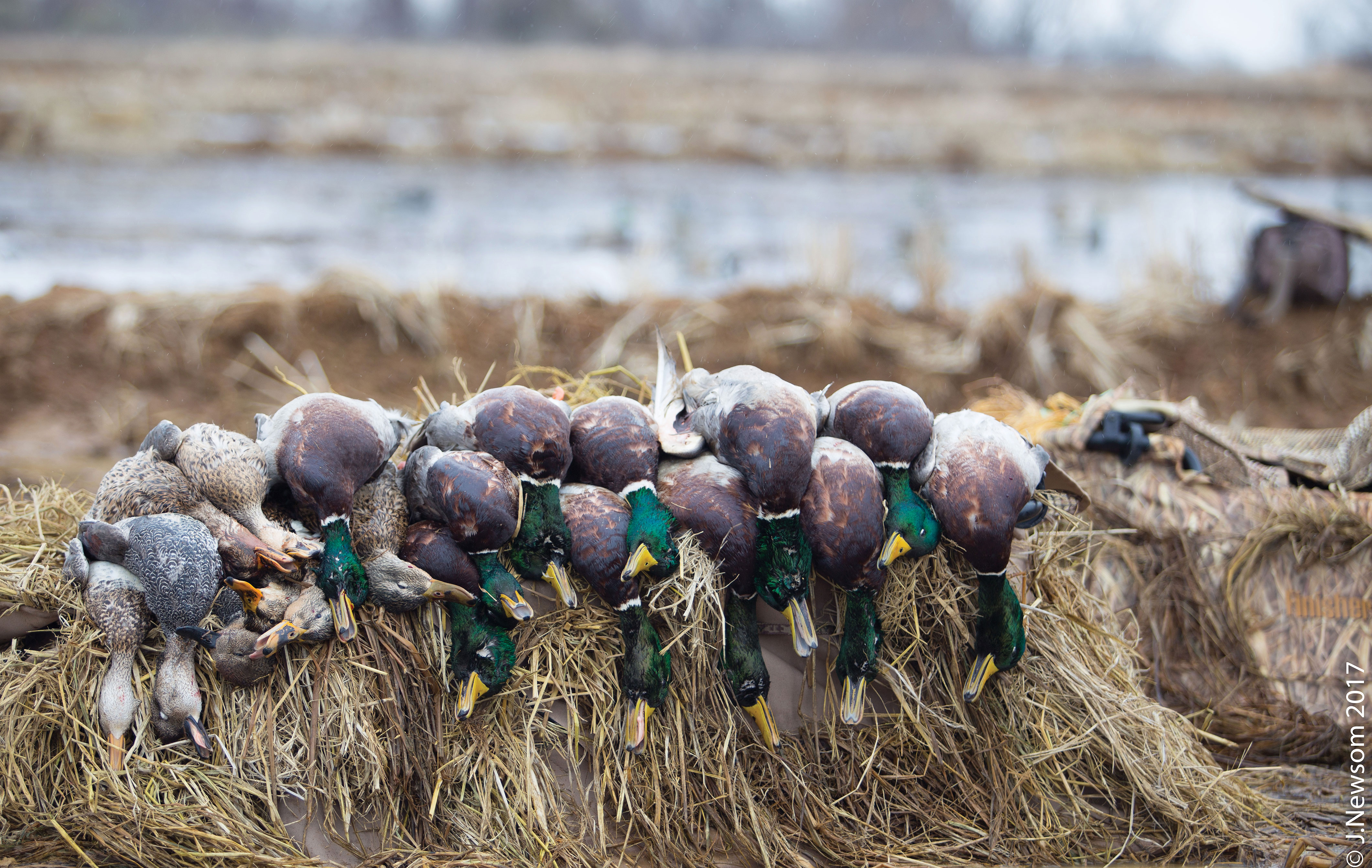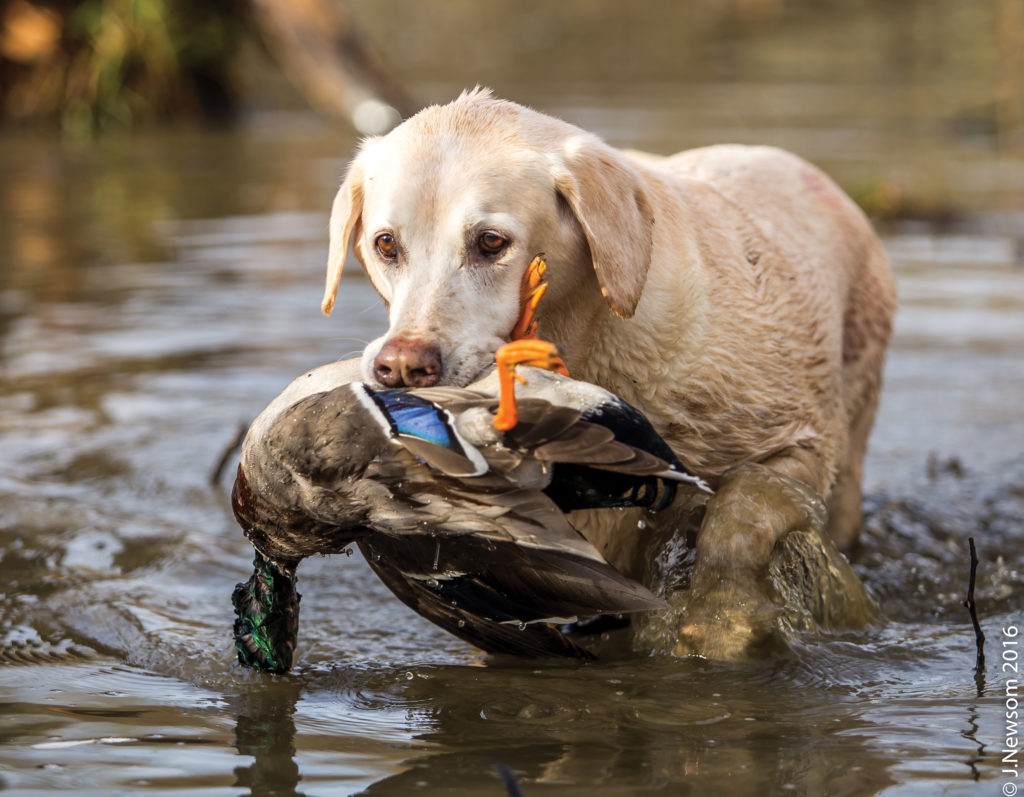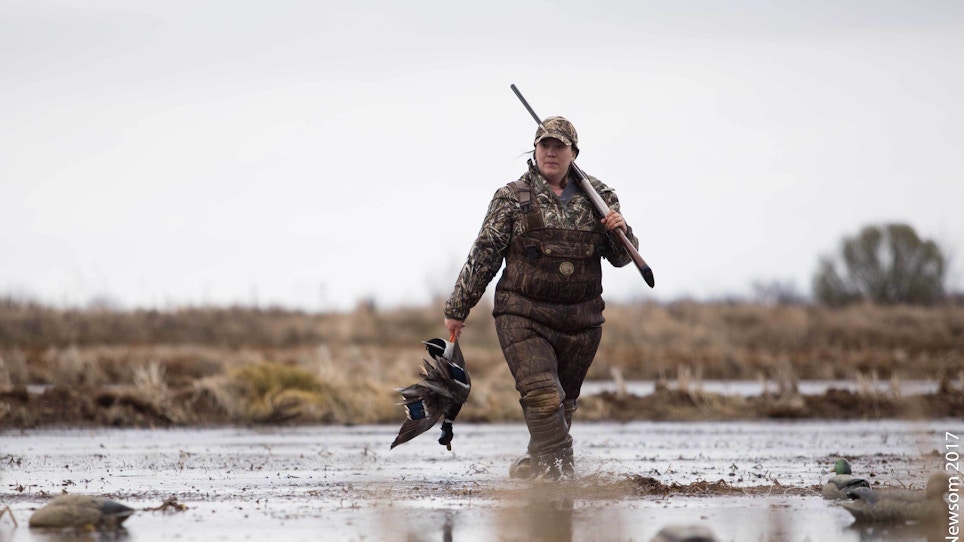When you’ve walked 200 yards through muck and water past your ankles in waders two sizes too big, fallen in the mud three times and used the stock of an expensive shotgun as support to get back up, spent three hours lying in four inches of water that seeps down your waders and trickles down to the small of your back every time you sit up, and hiked out in water-filled waders through mud so thick and difficult you start thinking about making a deal with God just to get out of it, you should be miserable.
If you do all that and you’re not miserable, you must be a duck hunter. “Sane” has never been a defining characteristic of duck hunters in general. Who else would go through all that work and water and mud and misery for, what, two pounds of meat?
But we do it, and we love it, and we gripe about it, and we’re a little relieved when season is over, and we can’t wait til season opens next year, and we’ll do it all again for as long as we’re able.
Such was the case for two days in January, when I joined Banded’s Jacob Wallace and his buddies Matt and Josh for some serious greenhead action in the flooded fields outside Roe, Arkansas. The last four days before my arrival had seen snow, ice and temps in the teens, but overnight it warmed up dramatically. It was 54 degrees Tuesday morning when we piled in the truck to hunt. The fields had thawed, and water was several inches thick with several inches of mud beneath that — crazy, suck-your-boots-off, thick gumbo mud. A series of unfortunate events left me hunting in borrowed waders that didn’t fit, but at least it wasn’t cold. Right?
After a hundred-yard walk in — a very slow, tippy, stumbling-over-roots walk — I opened a brand new Avery Finisher blind and got to work brushing and mudding it in while the guys set a modest spread of about 40 dekes, mostly mallards and full-body specklebellies. We set four layout blinds behind a levee and immediately got soaked, as the mud and water were inescapable. Water in the layout blinds, water in the blind bags, water on the camera gear. It was glorious — the exact kind of mess duck hunters live for.
And, of course, it was worth it. As legal light arrived, birds were everywhere, headed north. They’d been pushed south by the previous week’s cold front, and a strong south wind was pushing them back north to feed in the agricultural fields. Mallards came in singles and pairs all morning. The wind was blowing 20 mph at our backs, and the birds had trouble lining up in such strong winds, but we shot singles and pairs and a few gadwalls. A couple of specks looked at us a time or two, but never came low enough for a shot.

A wet-but-productive morning in the rice fields is a great alternative to the traditional flooded-timber hunting in Arkansas. (Credit: Josh Newsom)
We shot our 16th mallard of the day around 11 and started packing up to take photos. Somewhere in this process, while picking up decoys, I stepped off a levee into a hole and fell face-first into the water, soaking any bit of skin that might have stayed dry under my waders.
After packing up, wind still kicking, we peeled off our waders and did a little scouting on the way to Bindi’s— a prototypical small-town diner with duck boats in the parking lot, a “welcome hunters” sign out front, and chicken fried steaks bigger than your head. Isn’t it funny how lunch always tastes better when you’ve been hunting?
Day two. An enormous flooded rice field we wanted to hunt was loaded with birds — all feeding right in the middle. In all that mud, a four-wheeler was out of the question, so it was another comedy of errors as my giant borrowed waders and I fumbled, stumbled, fell and tripped our way through the levees in the dark.
Good thing for us it was 60 degrees out, because the layout blinds had four inches of water in them before we even got settled in. Birds started to pitch in and flare — it quickly became obvious that we didn’t have enough cover. We hopped up and moved the blinds 20 yards away where we had a little more foliage, but that didn’t seem to satisfy them, either. We moved the blinds a second time among some drier grass, knowing the birds really wanted to be about 50 yards over to our right.
The birds — mostly those famous Arkansas mallards and a few spoonies — came in pairs and singles as they had the day before, but they were warier than yesterday and didn’t want to finish as nicely as we hoped. The wind picked up, which didn’t help, but we eventually scratched out a limit, soaking our clothes with every volley, as water poured down the backs of our waders each time we sat up to shoot. Again, it was one of those times you just sit and think, “This is a ridiculous amount of work and silliness. Isn’t it great?”

This hunting style can challenge mobility. Having a retriever can help save time — and extra work — for your group. (Credit: Josh Newsom)
The walk in had been so tough for out-of-shape me (and I think the guys thought I was too slow) that they suggested I walk to the opposite treeline and take the road behind it, which we all assumed would loop around to the truck. It didn’t, and thus began an agonizing death march through solid mud so cakey that Matt eventually pulled off his waders and hauled them out barefoot, just to be able to keep going. He called it “the hardest walk I’ve ever taken outside the Marine Corps.”
That afternoon, while cleaning birds on the tailgate, we laughed at our self-imposed misery — the perfect example of just how crazy duck hunters really are.
If you’d like to launch your own epic tale of misery for the sake of good stories and plentiful greenheads, there’s no better place to do it than Arkansas. Wallace, a self-described “borderline mallard purist,” has been going there since 2001 for greenheads. He hunts Arkansas mallards in green timber, but when the weather doesn’t cooperate — and it frequently doesn’t — he takes advantage of flooded fields.
“The number one concern for me when hunting fields is concealment,” he says. “It’s above everything else.” Not a big fan of pit blinds, he uses layout blinds in the flooded fields and is careful to grass them in as much as possible with surrounding native vegetation.
“I like to see the birds finish directly in front of me instead of at different angles,” he says, “so as long as it’s feasible, I want the wind directly at my back every time.” And as usual, the key is being where the birds want to be. On the second day of our hunt, we moved the layout blinds to three different locations because the birds just wanted to land somewhere else. That’s the big advantage of layout blinds. “We like to limit pressure in our fields, and because of that, birds often want to be there as opposed to having to be coaxed in,” he adds. “Because we are using layout blinds and are mobile, scouting can make a big difference. In bigger fields, birds don’t always set up in the same area. Sometimes one corner pulls in more birds than the other side of the field. I like to know what section of the field the birds are using, and hunt accordingly.
“While I enjoy every minute of the hunt, I want to be in and out as soon as possible,” Wallace continues. “Less pressure tends to keep birds around longer.”
Staying mobile and flexible is really the key to chasing the birds into every corner of a flooded field, and the gear has to be up to the task. “Layout blinds can be an absolute pain to move around, but they’re key for the way we hunt,” Wallace says. “I personally use a Ground Force blind produced by Avery. Good comfortable waders are key for us, as we have to walk in and out of the fields to get to the areas we want to hunt. I use uninsulated Banded Redzone waders for field hunting.
“I’m a decoy snob — I readily admit it. Because of this, I only use GHG decoys. I do utilize different species, but the main decoy I use are GHG ProGrade Mallards with flocked heads. The realism and durability is tough to beat.”
There’s no doubt that Arkansas is still the Mecca for mallards. While the state’s famous for its timber hunting, the flooded fields offer terrific opportunities if you’re willing to put in the (sometimes grueling) work.
“I’ve been lucky enough to hunt in many states, multiple countries, and several continents,” Wallace says. “If I could only hunt one more place, it would be in Arkansas. I was fortunate enough to purchase a second home there; having great neighbors that I consider friends, the camaraderie of the hunting club, and of course, ducks, keep me coming back.”
Featured image: Josh Newsom






